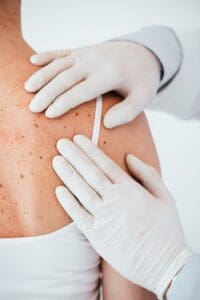Table of Contents
ToggleHow Removing Benign Skin Lesions Can Enhance Your Appearance
If you’ve ever caught yourself hiding a mole, cyst, or skin tag in photos or felt self-conscious about one on your face or neck, this article is for you. Even benign skin lesions can affect how we feel about our appearance, especially when they’re in noticeable areas. For men and women in Richmond and Central Virginia, Dr. Matthew G. Stanwix, a Board Certified Plastic Surgeon, provides expert lesion removal that not only ensures medical safety but also restores aesthetic balance. Keep reading to learn the cosmetic benefits of removing benign skin lesions.
Understanding Benign Skin Lesions
Benign skin lesions are non-cancerous growths that appear on the skin’s surface. These include moles, lipomas (fatty lumps), cysts, and skin tags. While they don’t usually pose a health risk, they can become irritated, grow over time, or create cosmetic concerns. Some may catch on clothing or cause discomfort, while others can draw unwanted attention to the face, neck, or hands.
Dr. Stanwix takes time to identify the type of lesion and select a removal technique that preserves surrounding tissue and minimizes scarring. The result is a skin that looks clean, smooth, and balanced without the visible reminders of surgery.
When Cosmetic and Medical Reasons Overlap
While some patients seek removal purely for cosmetic reasons, others have medical motivations as well. A lesion that bleeds, changes color, or grows rapidly may require evaluation to rule out malignancy. Focus on reconstructive and aesthetic surgery ensures that every procedure is both medically sound and cosmetically refined.
That’s the advantage of seeing a Board Certified Plastic Surgeon rather than opting for an in-office removal elsewhere.
Cosmetic Benefits of Removing Benign Lesions
The improvement goes far beyond what you see in the mirror. Here’s how removal can make a difference:
1. A Smoother, More Even Skin Surface
Removing benign skin raised or uneven lesions can make the skin appear smoother and younger. It eliminates textural distractions that often draw attention away from your natural features.
2. Balanced Facial Symmetry
Even small moles or bumps can disrupt facial harmony, particularly around the eyes, nose, or mouth. Precision removal restores balance and symmetry while maintaining your natural contours.
3. Boosted Self-Confidence
Many patients describe an immediate lift in confidence after removal, especially when they no longer feel the need to conceal the area with makeup or clothing. It’s a subtle but powerful transformation.
4. Improved Comfort and Functionality
Lesions near the collar, underarms, or waistline can cause irritation or snag on fabric. Removing them restores comfort and reduces the risk of recurring inflammation.
- Cleaner, Healthier Skin Appearance
After healing, the treated area blends smoothly with the surrounding skin, giving a fresher, more refined look. This small change often contributes to an overall impression of vitality and care.
The Procedure: Safe, Quick, and Tailored to You
Most benign lesion removals are performed in-office under local anesthesia. Depending on the lesion type, your doctor may use excision, shave removal, or advanced closure techniques to ensure the smallest possible scar.
The process typically takes less than an hour, and patients can return to normal activities the same day. Each removal is approached with the same level of detail.
Recovery and Results
Recovery from skin lesion removal is usually simple and quick. Mild redness or swelling may occur but resolves within days. Dr. Stanwix provides aftercare instructions and scar management guidance to ensure optimal healing.
Within a few weeks, patients often notice smoother skin texture and a significant improvement in how they feel about their appearance. Most scars fade to near invisibility with time, especially when the procedure is performed with meticulous closure and care.
Why Choose Dr. Matthew Stanwix
Patients from Richmond, Charlottesville, and Central Virginia trust Dr. Stanwix for his combination of surgical expertise, aesthetic judgment, and compassionate approach. His Ivy League education, Johns Hopkins training, and over 13 years of experience allow him to achieve results that look natural, not overdone.
Whether you’re removing benign skin like you are removing a facial mole for cosmetic reasons or a cyst that’s become bothersome, you’ll receive thoughtful, patient-centered care in a private, professional environment.
If you’ve been thinking about removing benign skin like removing a mole, cyst, or skin tag, take the next step with confidence. Stanwix Plastic Surgery offers safe, precise, and aesthetic skin lesion removal in Richmond, VA, guided by Dr. Stanwix’s advanced surgical expertise. Call (804) 355-3410 or visit to request your private consultation and start your journey toward smoother, clearer skin today.
If you’ve been frustrated with treatments that didn’t work, know that expert options exist right here in Richmond, VA. Dr. Stanwix can create a personalized scar revision treatment plan to finally help your scar fade into the background, where it belongs. Call us at 804-724-7244 to schedule a consultation today.
FAQs
- Does removing a mole or skin tag hurt?
Most procedures are done under local anesthesia, so you’ll feel little to no pain during removal. Any mild discomfort afterward can be easily managed with over-the-counter medication.
- Will there be a scar after lesion removal?
Dr. Stanwix uses fine, precise techniques and closure methods to keep scarring minimal. Over time, most marks fade to blend naturally with your skin tone.
- Can moles or lesions grow back after removal?
If the lesion is completely excised, regrowth is unlikely. Dr. Stanwix ensures full removal and may send tissue for pathology review if needed.
- How long does healing take?
Healing time depends on the size and depth of the lesion, but generally takes one to two weeks. Dr. Stanwix’s aftercare instructions help ensure quick, clean healing.
- Are all skin lesions safe to remove?
Yes, once the lesion has been confirmed as benign, your doctor evaluates your skin during the consultation to determine the safest removal method.

